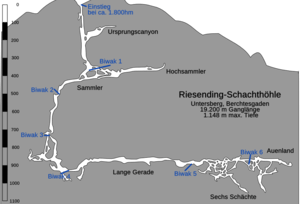Riesending cave

Riesending cave
The Riesending cave (German: Riesending-Schachthöhle) is a pit cave in Untersberg and is the deepest in Germany. It was discovered in 1996 and its name in German means "huge thing". It became well known to the general public for the largest ever rescue effort, taking eleven days by 700 members of a multinational group of cave rescuers to rescue 52-year-old Johann Westhauser, one of the original and principal researchers of the cave, a physicist, speleologist and cave rescuer himself, who had been injured in a rockfall deep in the cave in June 2014.[1]
See also
- Rescue in Riesending cave
References
| Wikimedia Commons has media related to Riesending cave. |
- ↑ "Riesending rescue: German caver Johann Westhauser surfaces". BBC. Retrieved 19 June 2014. (NB. The article incorrectly states that the cave was discovered in 1995 by Johann Westhauser himself, however, the cave was discovered in 1996 by Hermann Sommer and Ulrich Meyer, but first explored by a team including Johann Westhauser in 2002.)
Coordinates: 47°41′58″N 12°58′59″E / 47.6994°N 12.9831°E
This article is issued from Wikipedia - version of the 11/16/2016. The text is available under the Creative Commons Attribution/Share Alike but additional terms may apply for the media files.